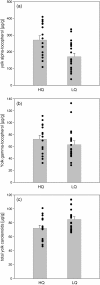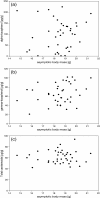Environmental effects shape the maternal transfer of carotenoids and vitamin E to the yolk
- PMID: 22876878
- PMCID: PMC3502133
- DOI: 10.1186/1742-9994-9-17
Environmental effects shape the maternal transfer of carotenoids and vitamin E to the yolk
Abstract
Introduction: Maternal effects occur when the phenotype of the offspring is influenced by the phenotype of the mother, which in turn depends on her heritable state as well as on influences from the current and past environmental conditions. All of these pathways may, therefore, form significant sources of variation in maternal effects. Here, we focused on the maternal transfer of carotenoids and vitamin E to the egg yolk, using canaries as a model species. Maternal yolk carotenoids and vitamin E are known to generate significant phenotypic variation in offspring, representing examples of maternal effects. We studied the intra-individual consistency in deposition patterns across two years and the mother-daughter resemblance across two generations in order to estimate the level of heritable variation. The effects of the current environmental conditions were studied via a food supplementation experiment, while the consequences of past environmental conditions were estimated on the basis of the early growth trajectories.
Results: There was a significant effect of the current environmental conditions on the yolk carotenoid and vitamin E deposition, but this effect varied between antioxidant components. The deposition of yolk carotenoids and vitamin E were linked to the process of yolk formation. Past environmental conditions did not contribute to the variation in yolk carotenoid and vitamin E levels nor did we find significant heritable variation.
Conclusions: The transfer of carotenoids or vitamin E may be an example where current environmental variation is largely passed from the mother to the offspring, despite the numerous intermediate physiological steps that are involved. Differences in the effect of the environmental conditions as experienced by the mother during laying may be due to differences in availability as well as physiological processes such as competitive exclusion or selective absorption.
Figures



Similar articles
-
Sources of variation in yolk hormone deposition: consistency, inheritance and developmental effects.Gen Comp Endocrinol. 2012 Jan 15;175(2):337-43. doi: 10.1016/j.ygcen.2011.11.034. Epub 2011 Nov 29. Gen Comp Endocrinol. 2012. PMID: 22146794
-
Maternal effects mediated by egg quality in the Yellow-legged Gull Larus michahellis in relation to laying order and embryo sex.Front Zool. 2011 Oct 19;8(1):24. doi: 10.1186/1742-9994-8-24. Front Zool. 2011. PMID: 22011400 Free PMC article.
-
Heritable variation in maternal yolk hormone transfer in a wild bird population.Am Nat. 2009 Oct;174(4):557-64. doi: 10.1086/605379. Am Nat. 2009. PMID: 19737108
-
Hormonally-mediated maternal effects in birds: Lessons from the flycatcher model system.Gen Comp Endocrinol. 2015 Dec 1;224:283-93. doi: 10.1016/j.ygcen.2015.09.016. Epub 2015 Sep 21. Gen Comp Endocrinol. 2015. PMID: 26393309 Review.
-
Chemical and physiological behavior of feed carotenoids and their effects on pigmentation.Poult Sci. 1992 Apr;71(4):711-7. doi: 10.3382/ps.0710711. Poult Sci. 1992. PMID: 1594522 Review.
Cited by
-
Maternal effects and maternal selection arising from variation in allocation of free amino acid to eggs.Ecol Evol. 2015 Jun;5(12):2397-410. doi: 10.1002/ece3.1524. Epub 2015 May 29. Ecol Evol. 2015. PMID: 26120429 Free PMC article.
-
Conspicuous carotenoid-based pelvic spine ornament in three-spined stickleback populations-occurrence and inheritance.PeerJ. 2015 Apr 2;3:e872. doi: 10.7717/peerj.872. eCollection 2015. PeerJ. 2015. PMID: 25861558 Free PMC article.
-
Antioxidant systems in chick embryo development. Part 1. Vitamin E, carotenoids and selenium.Anim Nutr. 2016 Mar;2(1):1-11. doi: 10.1016/j.aninu.2016.01.001. Epub 2016 Jan 11. Anim Nutr. 2016. PMID: 29767100 Free PMC article. Review.
-
Larval Pigmentation Reveals Environmental and Genetic Influences in Hybridizing Ambystoma Salamanders.Ecol Evol. 2025 Aug 3;15(8):e71911. doi: 10.1002/ece3.71911. eCollection 2025 Aug. Ecol Evol. 2025. PMID: 40755891 Free PMC article.
References
-
- Rossiter MC. The incidence and consequences of inherited environmental effects. Annu Rev Ecol Evol Syst. 1996;27:451–476. doi: 10.1146/annurev.ecolsys.27.1.451. - DOI
-
- Mousseau TA, Fox CW. Maternal effects as adaptations. New York: Oxford University Press; 1998.
-
- Bernardo J. The particular effect of propagule size, especially egg size: patterns, models, quality of evidence and interpretation. Am Zool. 1996;36:216–236.
LinkOut - more resources
Full Text Sources
Miscellaneous

